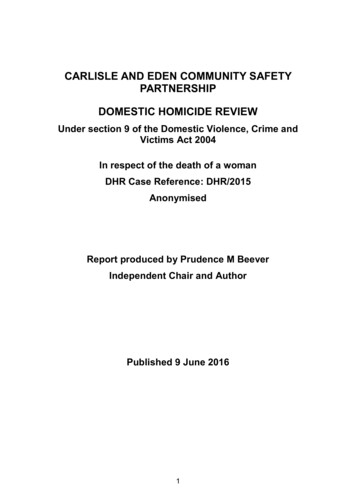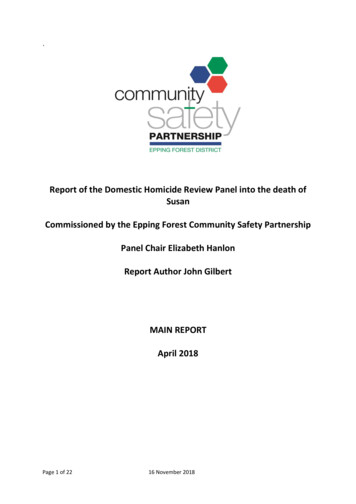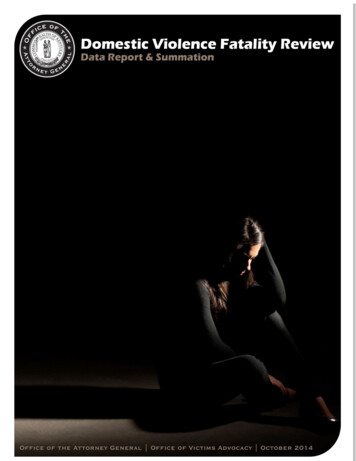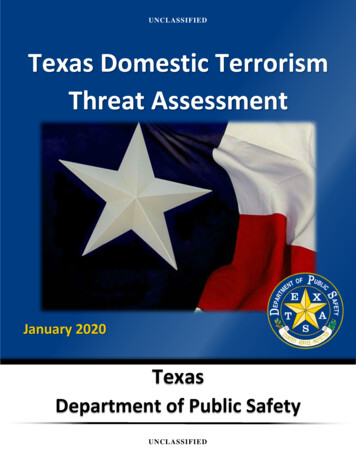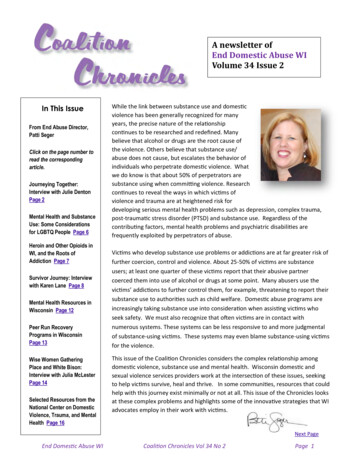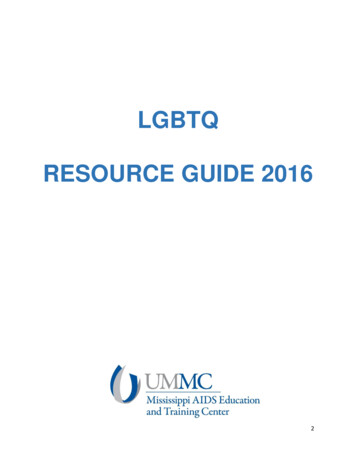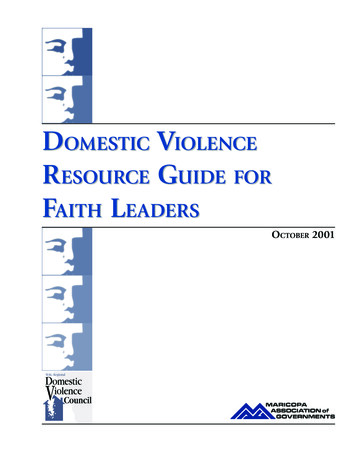
Transcription
DOMESTIC VIOLENCERESOURCE GUIDE FORFAITH LEADERSOCTOBER 2001
IMMEDIATE R ESPONSE(Note: Use this resource as a “Quick Reference Guide” in the eventthat a victim unexpectedly comes to you for assistance)Some things to remember: Never counsel a victim and abuser together. Determine the level of the victim’s safety. Allow the victim to make the decisions. Keep all information confidential.If the victim contacts you by phone: Assess the safety of the victim and his/her children. If there is an immediate threatof violence call 9-1-1 immediately! Do not go to the scene of an incident in progress. If the abuse is over, ask the victim if the police have been called or if she/he wouldlike you to contact police for them. Inquire about the need for medical assistance. If the abuser is not present or has been removed, encourage the victim to seek shelterfrom a trusted friend or family member or through a domestic violence shelter.To get immediate assistance contact the National Domestic Violence hotline:1(800) 799-SAFE (7233)For local assistance call the shelter hotline:(602) 263-8900 or 1(800) 799-7739You can also utilize the resource section of this manual for all shelter programs in Arizona.How to respond to a victim: Support the victim completely. Determine the level of the victim’s safety. Assist with getting the victim appropriate resources. Let the victim decide what is best for her/him and the children.What you can say to the victim: You are not alone. You are a brave person. I know it wasn’t easy to call me. I won’t tell anyone unless you want me to. Usually if he/she hit you once they will most likely do it again. I’m afraid for your safety. The congregation will support you if/when you are ready to leave. You don’t deserve to be abused.Domestic Violence Resource Guide for Faith Leaders1
2Domestic Violence Resource Guide for Faith Leaders
TABLE OF CONTENTSImmediate ResponseIntroductionThe Good Stranger. 5Domestic Violence OverviewWhy and How Faith Communities Should Respond . 7Domestic Violence 101. 9Speaking to a Victim.13The Offender in Your Congregation.17The Criminal Justice Response .20Vulnerable PopulationsEffects on Children.23Teens and Dating Violence.25Domestic Violence in an Aging Population.27In the WorkplaceWhen Domestic Violence Enters the Workplace .29Interfaith PerspectivesThe Protestant Perspective . 31The Catholic Perspective .34The Jewish Perspective. 41The Muslim Perspective .42APPENDICESA.B.C.D.E.F.G.Local Resources.47Safety Plans.50Lethality Assessment .52Information Wheels .53Values/Principles and Affirmations .63Sample Messages .64Policy Samples.94Domestic Violence Resource Guide for Faith Leaders3
4Domestic Violence Resource Guide for Faith Leaders
INTRODUCTIONFaith-based institutions are not immune to the destructive effects of domesticviolence. National research has shown that one out of every 4 members ofa congregation is a victim or survivor of domestic violence. Additionally,research has shown that victims are more likely to seek help from their churchbefore turning to community resources. Many victims have reported that whenthey did turn to their religious leaders, they often were not understood or weregiven poor advice for dealing with their volatile situation.The MAG Domestic Violence Resource Guide for Faith Leaders is an initiative ofthe Maricopa Association of Governments (MAG) Domestic Violence Council,and was created with the help of representatives from a variety of faith-basedorganizations. Faith communities are in a unique position to assist victims andtheir children by providing spiritual and emotional support, as well as resources,to help deal with the devastating effects of domestic violence.It is recommended that this guide be utilized as a part of forming a comprehensive response in your religious institution to helping victims and theirchildren to stay safe and to hold batterers accountable.Many thanks go out to those individuals from the various faith communitiesand advocacy organizations who contributed to the information in this manual.Also, we would like to acknowledge the Philip Morris Doors of Hope Fund forproviding the necessary financial support needed to develop this manual.For more information on forming a comprehensive response in your faithorganization, please feel free to contact Kristina Rivera at (602) 254-6300.Domestic Violence Resource Guide for Faith Leaders5
The Good StrangerBy Esther Barnes, Adapted by Rev. Marie FortuneAs a woman was traveling the road between romance and reality, she fell inlove with the charming but insecure young man.And it came to pass that after they were married, he beat her and robbedher of her dignity, and she ran from the house bruised and afraid, wishingshe were dead.A faith leader saw her swollen face and stopped to give some advice, “Wives,submit to your husbands,” he read. And he excused himself to attend aseminar on Motivating Strong Leaders.A doctor stopped and bandaged her face and gave her a prescription for Valium.A women’s group leader hearing her sobs felt a rush of pity. “I don’t know whatshe sees in him,” she thought and was thankful for her own gentle husband.And she went to buy the young woman a book on Making Your Marriage Work.A police officer asked her if she needed help. She asked him to arrest herhusband. The officer asked if there were any witnesses to the assault. Sincethere were none, he left her alone.Another women’s group president learned she was wandering the streets alonewithout a purse, her clothing torn, and said to the treasurer, “How awful! Poordear!” And they agreed something should be done, and that they would bringit up at their next meeting.A social worker noticed her and stopped to talk, “What did you do to provokehim?” she asked. The battered woman turned and walked away. The socialworker concluded she did not want help.And while the battered woman was wondering where she would sleep thatnight, a stranger greeted her and said, “Sister, come with me. We’ll get somefood at the crisis center and maybe some clothes.” She took her threadbarecoat and placed it on the woman’s shoulders.And when they found the Crisis Center had no empty beds, the stranger tookthe woman to her attic room, and cooked a macaroni dinner and cannedpeas on a hot plate. She made a pot of tea and listened to the incoherentbursts of pent-up pain. She wept to hear the broken dreams, self-doubt and shattered faith. And as the woman dropped to sleep upon the couch, the strangerbreathed, “You’re a survivor, like me,” and made herself to lie upon the floor.Which of these people was a neighbor to the woman who fell into the handsof the abuser?The one who had compassion on her.Go and do likewise. Go and do likewise.6Domestic Violence Resource Guide for Faith Leaders
DOMESTIC VIOLENCE OVERVIEWWhy and How Faith Communities Should Respondto Domestic ViolenceFaith communities are not immune to the destructive forces of domesticviolence. In fact, one of every four members of a congregation is a victim ora survivor of domestic violence (Rev. Marie Fortune, 1995). The responsibilityto offer help and be a prophetic voice in the prevention of family violenceis recognized by many religious institutions as fundamental to the values ofjustice, equality, and the protection of human dignity. To ensure the physicalsafety and spiritual well-being of their members, faith communities must beprepared to respond with knowledge and compassion.The faith leader is often the one who is turned to in a time of crisis. Additionally, the faith community may be one of the few places the batterer does notcontrol or restrict the victim’s movements. Leaders of the faith communitiesalso may be more accessible in terms of proximity and usually do not chargeto see someone in need.As a community of faith there are several practices that are helpful to allcongregation members experiencing family violence.SUGGESTED PRACTICES INCLUDE:Become a Safe PlaceMake your congregation a safe haven where victims of domestic violence cancome for help. Have brochures and posters in places where a victim can takethe information with out fear of discovery. Telephone numbers should beincluded for the local shelters and national hotlines. Many times this information is best placed in restrooms.Educate the CongregationMembers of the community of faith can learn about family violence throughnewsletter articles, in bulletins, and in seminars through adult education.Domestic violence should also be a topic of discussion in marriage preparationclasses. One religious leader mentioned in the congregation newsletter thatthey would be out of the office participating in a workshop on domestic violence. Soon after, congregants were coming forward with requests for assistancerelated to family violence. The leader had opened the door to the congregationand let it be known the faith community was ready to provide assistance.Speak OutWhen appropriate, messages from the spiritual leaders should address familyviolence. This may be when a scriptural lesson is focused on a relevant topicsuch as suffering, victimization or during the month of October, DomesticDomestic Violence Resource Guide for Faith Leaders7
Violence Awareness Month. (See Appendix F for Sample Messages). Provideopportunities to make a difference. Encourage volunteers to assist shelters orother domestic violence agencies. Include information about opportunities towork with a coordinating council to develop and implement action plans.Support Domestic Violence SheltersThis can be an outreach with time, talent or dollars. The youth group can helpwith hands-on projects, such as holding a work day at the shelter or collectingitems for shelter use. The adults of the congregation can provide additionalsupport in donation of goods and services, or financially.Make Your Community of Faith One that Protects Victims and HoldsOffenders AccountableMake certain there are books available for battered women to read. A listfor the library is provided in the Resource Appendix A. Make informationavailable so a victim can take it and read it discreetly and then leave it behindif necessary.8Domestic Violence Resource Guide for Faith Leaders
Domestic Violence 101Domestic violence is a pattern of coercive control in an intimate relationship.This control may be seen in physical assault or in more subtle, but equallydevastating ways. Verbal, emotional, financial, and sexual abuse, as well asisolation, also falls under the realm of abusive behaviors. Domestic violencecrosses all racial, ethnic, economic, and religious communities.Domestic violence is a crime that conservatively affects 25% of all Americanfamilies. It is often a silent crime, hidden behind family doors. Most oftendomestic violence is an ongoing, debilitating experience of physical, psychological, and/or sexual abuse (American Medical Association definition). TheSurgeon General of the United States reports that one out of five womenbattered by her partner has been victimized over and over by the same person.PROFILE OF A VICTIMSimply being female is the single greatest factor that increases one’s risk ofbecoming a victim of domestic violence. Statistics show that in 95% of alldomestic violence cases, women are the victims (Bureau of Justice Statistics,1994). Gender is where the commonalities among victims ends. Victims are ofevery age, class, race, religious, geographic, sexual orientation, and personalitygroup. In the United States, nearly one in three adult women experience at leastone physical assault by a partner during adulthood (American PsychologicalAssociation, Presidential Task Force on Violence and the Family 1996 Report).STATISTICS Every 9 seconds a woman is battered in the U.S.Only 1 out of every 10 victims of domestic violence report the incident.Annually, 1 out of every 10 elderly persons is victimized.Domestic violence is the leading cause of injury to women between theages of 15 and 44.Domestic violence results in hundreds of millions of dollars in health carecosts alone in the U.S., much of which is paid for by employer benefits.Between one and four million American women are abused by currentor former husbands or boyfriends each year.Leaving an abusive partner increases, rather than decreases, the likelihood that the victim will be seriously assaulted or killed.MYTHS AND REALITIES OF DOMESTIC VIOLENCE Domestic violence affects only a small percentage of the total population.According to national research, domestic violence occurs in approximately28% of the population. It is estimated that 90 percent of all incidents arenot reported. A survey by the United Methodist Church showed that one inDomestic Violence Resource Guide for Faith Leaders9
thirteen members responding had been physically abused by a spouse and onein four had been verbally or emotionally abused. Domestic violence only occurs in lower class or poorer families.Abusers and victims come from every race, religion, and socioeconomicbackground. Wealthier victims more often have access to assets so they do notrequire community resources. In addition, wealthier victims have more to losein terms of status if the abuser is arrested. Alcohol and/or drugs cause domestic violence.Alcohol and/or drugs may increase the frequency and severity but do notcause domestic violence. Battering is just a momentary loss of temper and usually does notoccur more than once.The U.S. Surgeon General reports that 1 out of every 5 women battered byher partner has been victimized repeatedly by that partner. Leaving an abusive relationship is easy.The U.S. Department of Justice reports that the most dangerous time for awoman who is being battered is when she leaves. Abuse is the result of an anger problem.Abuse is not caused by a problem with anger, it is an issue of power and control.WHY VICTIMS STAYMany victims of domestic violence do leave their abusive partners. TheNational Coalition Against Domestic Violence estimates that on average, avictim returns to the abuser six times before finding the resources to finallybreak free from the relationship. Victims are faced with many barriers whichprevent them from leaving. These barriers can include: 10Fear of Increased Violence — The lethality of the violence oftenincreases when a batterer believes his/her partner is leaving the relationship. In fact, victims are most likely to be murdered when attempting toreport abuse or leave the relationship. The batterer may have threatenedto kill him/herself, the victim, the children, and/or friends and familyif the victim attempts to leave. Immobilized with psychological andphysical trauma, the victim often sees no way to protect herself.Domestic Violence Resource Guide for Faith Leaders
Frequency and Severity — The violence may occur over a relativelyshort period or there may be a long period between battering incidents.The batterer may promise that the last act of violence will be the last. Lack of Financial Resources — Batterers often control all access to thefamily resources. Without money or transportation the victim oftenhas no place to turn. The majority of women on welfare are pastvictims of domestic violence, as are most homeless women. The victimmay stay with the batterer to avoid the poverty she and her childrenwill experience. Isolation — The batterer may be the only emotional support left forthe victim as a result of either voluntarily or being forced to cut offrelationships with friends and family. Cultural Beliefs — The victim may hold cultural or religious beliefswhich support keeping the family together at all costs. Prior History of Abuse and Low Self-Esteem — There may be agenerational history of witnessing domestic violence in the familyand/or of being abused. The victim may have learned to accept abuseas normal behavior because at an early age abuse was consideredacceptable when someone had done something wrong. The victimmay believe that the abuse is deserved and accepts responsibility forthe batterer’s behavior. Feelings of low-self worth and helplessness arecontinually reinforced by the batterer.DOMESTIC VIOLENCE AND ALCOHOL/DRUG ABUSEAlthough many studies show a high correlation of alcohol/drug abuse anddomestic violence, there is no evidence that suggests a cause-and-effect relationship between the two. There are some characteristics that are shared. Thesewould include: Intergenerational abuseDenial or minimization of the problemIsolation of the familyThere are some findings that indicate that a battering incident coupled withalcohol/drug abuse may be more severe and result in greater injury. The batterermay state if the alcohol or drug abuse is treated, the battering problem will betreated as well. This is not the case and batterers’ intervention counseling mustbe coupled with chemical dependency counseling. One cannot be substitutedfor the other.Domestic Violence Resource Guide for Faith Leaders11
It is possible that someone coming to seek assistance with alcohol use maybe using alcohol to cope with violence in the family. If a batterer complainsabout the victim using too much alcohol or perhaps drugs, it may be a selfmedicating attempt to deal with the pain. A batterer may use alcohol or drugsto ease the pain of low self-esteem or otherwise self-medicate.Ann Ganley has created a distinction between hands-on and hands-off battering. Hands-on battering is physical or sexual abuse. This can include anyattack on the person, from slaps and unwanted touching, to fractured bonesand rape. The hands-off battering is a non-physical assault. This may bepsychological abuse or forced activities such as cleaning the house during themiddle of the night when the victim has to go to work the next morning.Additional hands-off abuse may control victims’ activities such as where theygo and with whom, or to attack victims’ self-esteem or do things to intentionally frighten the victim such as reckless driving.Although the hands-on battering is more likely to kill the victim, the hands-offabuse will require some type of treatment and take a great deal of time to heal.12Domestic Violence Resource Guide for Faith Leaders
Speaking to a VictimWho is a victim of battering? Can you tell by looking? It is more thanbruises, black eyes and broken bones. Battering is a pattern of coercive andcontrolling behavior, which is used to maintain power and control over thevictim. Although the batterer may not have physically assaulted the victim, theterror and fear are still there.It is very unlikely a victim will appear in your study one day and state, “I ambeing abused by my partner.” There may be a suspicion that all is not wellwithin the family. Most of the time, it will take a measure of gentle probingto elicit information.INDICATORS OF POSSIBLEDOMESTIC VIOLENCE VICTIMInjuries which are inconsistent with the explanation.Embarrassment or attempts to hide injuries.Quiet or frightened demeanor in partner’s presence.Tense, jittery and deferential to partner.May complain of “nervous stomach” or “sleeplessness.”Mention partner’s temper.History of repeated injuries.Multiple injuries in stages of healing.History of depression, possible suicide attempts.Edginess, fearfulness, high anxiety.Questioning a possible victim of domestic violence can be very difficult. Itmay take some time getting used to bridging the gap between being uncomfortable and reaching out to someone. We do not recommend that you ask,“Are you a victim of domestic violence?” This is not advisable because it leavesthe definition open to self-interpretation. I may be a victim, but I do not fitthe definition of a battered person in my own mind. We also do not advocatefor asking questions that are too evasive, “So, how have you been?” Questionssuch as these are too broad and they are easy to skirt around the true issue.Questions can be asked gently. The following list gives suggestions on questions that can be used to elicit information: “You seem upset. What is troubling you?” “What’s it like for you at home?” “What happens when you and your partner disagree?” “Do you have to account for your time?” “Are you ever afraid of your partner?”Domestic Violence Resource Guide for Faith Leaders13
“I’m sorry this happened to you.”“Does your partner push you around or hit you?”When speaking with a domestic violence victim, the most important thing isto listen to the story fully and believe the victim. You may be the first person tohear the entire story. Support and care for victims and let them know someoneis there for them.A victim needs to be listened to and then supported. An appropriate commentis, “This is not the life you were intended to have.” Other things to say include,“It is not your fault” and “You don’t deserve to be abused. ”The next step isto let the victim know they are not alone and help is available. The victimmay not be aware of community resources that will offer assistance. Theseresources can range from support groups to shelters and transitional housing.Other resources may include financial support if the family qualifies, day careif needed, career planning and training, and a myriad of support services. It isimportant to let the victim know help is available and how to access it.The first step is to assist the victim in assessing his or her safety. A safety planhas been included in Appendix B. It is also helpful at this point to offer thevictim an opportunity to call a local shelter program, not necessarily to seeif space is available but to speak to an advocate. These advocates are trainedin safety planning and many other aspects of victim services and can bebeneficial in assisting the victim when making decisions on how to proceed.During all of this, it is vital to simply offer suggestions and support and allowthe victim to make decisions. Victims are the experts about the relationshipand will make the best decisions based upon their knowledge. If there arechildren involved, care must be taken to ensure their safety. If the victimdecides to return to the abuser, it may be necessary to make a report to ChildProtective Services.It is important to tell the victim that you will be reporting the potential dangerfor the children and offer the option of making alternative arrangements forthem. If there is any reason to believe the children have already been harmed,it is usually beneficial for the victim to file a report. This will demonstratecooperation to the authorities. This may lead to an offer of support servicesfor the victim and the children.The primary goal of assisting a victim of domestic violence is to protect thevictim from further abuse. With this in mind, the religious leader shouldremember to: Listen and believe. Assist the victim in assessing the danger. Make referrals to appropriate resources.14Domestic Violence Resource Guide for Faith Leaders
LISTEN AND BELIEVEThe victim is sharing a very personal and painful part of her or his life. Itis important to take the time to let the victim tell the story without beinginterrupted or rushed. Do not add comments that belittle the experience suchas “I can’t believe he did that” or “Are you sure he meant to hurt you?”These comments tend to make the victim feel further isolated. Appropriatecomments such as “That must have been frightening” or “You certainly havebeen through a difficult time” can be useful in assisting the person in tellingthe story and validating the experience.ASSIST IN ASSESSING THE DANGERA victim is the person who knows the most about the batterer and is bestqualified to determine the potential danger of the situation. A lethality assessment will include consideration of the abuser’s access to weapons, and ahistory of violence in this and other relationships.A lethality assessment is located in the resources section of this manual inAppendix C.A safety plan is another important part of assisting a victim of family violence.This document will aid victims in developing a plan to ensure safety as well asthe safety of their children. This may be something victims cannot take withthem. It can be an opportunity to have someone sit down and think throughthe situation. This may be an excellent time to offer the victim an opportunityto call one of the shelters and speak with an advocate. It is important to assurethe victim it is not necessary to be prepared to leave in order to speak to anadvocate. The person at the shelter can assist with developing a safety plan andoffer other resources as well.It is vital to refrain from encouraging a victim to participate in couplescounseling. This will place the victim in a difficult situation. Couples counseling is based on both partners having equal standing in the relationship. Thisdoes not occur when there is violence in the home. Couples counseling willallow the batterer to continue to control the victim, in front of a therapist. It iswise to remember that changing the behavior of the victim cannot change theactions of the batterer. It is not the victim’s responsibility to stop the violence;it is the responsibility of the batterer.Victims of domestic violence do not fit into a pattern nor are they all alike.They do share some characteristics. Some of these include: May blame self for the violence. May exhibit low self-esteem (may be magnified by batterer’s confirmation that the victims is “worthless”). May minimize or deny the violence.Domestic Violence Resource Guide for Faith Leaders15
May be isolated from family, friends and other support systems.May exhibit unpredictable behavior (because of batterer’s unpredictable behavior).May feel shame and guilt.May characterize themselves as a traditionalist within the family.May accept responsibility for the batterer’s actions and believe the“punishment” is deserved.May use sexual relations to establish intimacy.May believe they can assist the batterer in changing his/her behavior.May believe the batterer can be helped without outside intervention.WHY DO VICTIMS STAY?Victims have many reasons to stay in an abusive relationship but the mostcommon is the love that still remains for their partner. The goal for them isnot to end the relationship, but to end the abuse. A victim finds it difficult tohold the batterer accountable for the behavior and excuses the behavior due tostresses at work or in the family. The victim may assume the responsibility formaintaining the peace in the home. At other times, victims believe they will beable to change their partner’s behavior.A victim may have been told many times by the batterer that if they don’tstay together, the victim will be with no one. The definite implication is ifthe victim attempts to leave, the batterer will make certain the victim willnot live to be with anyone else. The victim knows this threat is real and canbe carried out. If the victim states that they are afraid to leave, they must bebelieved and extreme care must be taken to ensure the safety of the victimand any children.Another very common reason for victims to stay is the belief that childrenneed both parents in the home. It is often very difficult for a victim to believethe family can survive without the other parent economically or emotionally.Many times the victim has been told the family must stay together at all costs.All of this leads to a concerted effort to keep the relationship intact.A community of faith is a place where a victim has the right to expect supportand understanding. Victims have already suffered greatly within the relationship and may look to their faith community to be a source of healing.16Domestic Violence Resource Guide for Faith Leaders
The Offender in Your CongregationPOSSIBLE INDICATORS OF ADOMESTIC VIOLENCE BATTERERJealous and possessive of partner.Intimidates partner in front of others.Discredits partner in front of others.Attempts to convince others partner is crazy.Batterers are not all alike. They may, however, share some characteristics. Abatterer: may have intense and dependent relationships with their partner.may abuse alcohol and drugs.may be traditionalists and believe in male supremacy and other genderstereotypes.may have experienced or witnessed violence in the family of origin.may have poor impulse control and limited tolerance for frustration.may have a criminal record.may have low self-esteem.may be extremely jealous and overprotective
Domestic Violence Resource Guide for Faith Leaders 7 DOMESTIC VIOLENCE OVERVIEW Why and How Faith Communities Should Respond to Domestic Violence Faith communities are not immune to the destructive forces of domestic violence. In fact, one of every four members of a congregation is a victim or a survivor of domestic violence (Rev. Marie Fortune .
